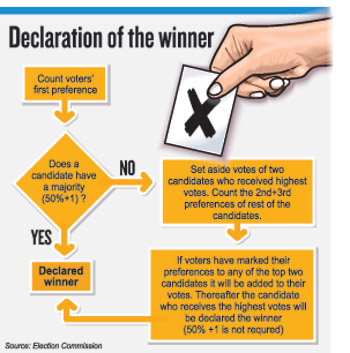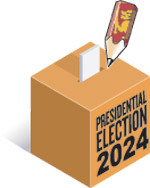News
A possibility of second and third preference votes coming into play
 With the possibility of the preference vote coming into play at the upcoming Presidential polls, organisations monitoring elections have emphasised the need to educate voters on marking their second and third preferences.
With the possibility of the preference vote coming into play at the upcoming Presidential polls, organisations monitoring elections have emphasised the need to educate voters on marking their second and third preferences.
With at least three main candidates contesting this presidential election they pointed out that the preference vote may be important in deciding the winner.
The preference vote is taken into account in the event a candidate fails to obtain 50 per cent + one vote in the first round of counting.
Executive Director, Institute for Democratic Reforms and Electoral Studies Manjula Gajanayake told the Sunday Times that they will make arrangements to raise awareness at village level on the importance of indicating the second and third preferences when marking the ballot paper.
Election Commission former chairman Mahinda Deshapriya pointed out that since three main candidates and others are due to contest the Presidential Election, it is possible that the second and third preferences may have to be counted in this election.
According to Presidential Election Act No. 1 of 1981, if no candidate obtains over 50% + one vote of the valid votes, the 2nd and 3rd preferences of the candidates, excluding the top two candidates are taken into account.
Accordingly, at the Presidential Election, voters can vote for three candidates, as 1, 2, and 3 respectively, based on their preferences. Also, if one prefers only one candidate, they can mark 1 or a cross when voting.
 Mr Deshapriya explained that if there are five contestants namely, A, B, C, D with the overall valid number of votes is 100 resulting A-40, B-35, C-15, D-6 E-4 the counting goes to the next round.
Mr Deshapriya explained that if there are five contestants namely, A, B, C, D with the overall valid number of votes is 100 resulting A-40, B-35, C-15, D-6 E-4 the counting goes to the next round.
The contest will then be between A and B with their votes placed aside and a second round of counting taking place in which the second and third preference votes of C, D, and E will be counted.
“That means, 2nd and 3rd preferences marked in favour of A and B, in the ballots received by C are counted and added to their overall totals.
He said, if no additional votes are received by either A or B after counting the preferences received in C, D, and E’s ballots, A who obtained 40 votes in the first round of counting, becomes the winner.
Mr Deshapriya said that if A and B have obtained an equal number of votes, the Election Commission will add an additional vote to one person and select the winner by drawing lots.
He said in the Presidential Election held in 1982, an alternative organisation called the Janata Sang Amaya promoted among the people to give the 1st preference to the candidate Vasudeva Nanayakkara and the 2nd preference to Hector Kobbekaduwa. In 1988, the Communist Party worked to inform the people to give 1st preference to Ossie Abeygunasekera and 2nd preference to Sirima Bandaranaike. However in all 8 presidential elections held so far, in the first round itself the winner obtained over 50% of the vote.
The best way to say that you found the home of your dreams is by finding it on Hitad.lk. We have listings for apartments for sale or rent in Sri Lanka, no matter what locale you're looking for! Whether you live in Colombo, Galle, Kandy, Matara, Jaffna and more - we've got them all!

